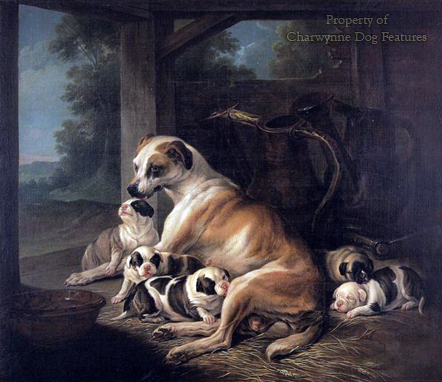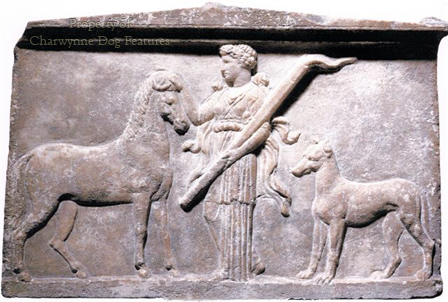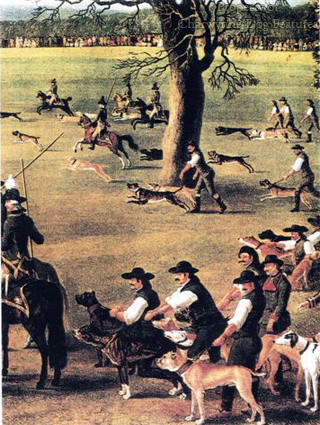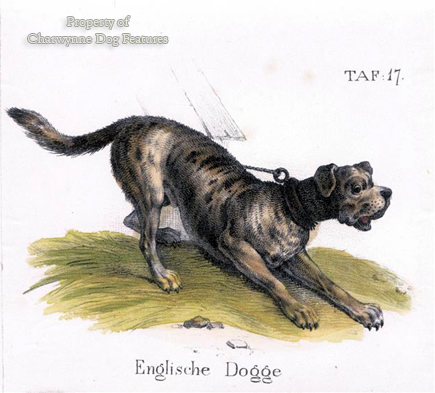426 Mastiffs Molossers & Mtn Dogs
MASTIFFS, MOLOSSERS and MOUNTAIN DOGS
by David Hancock
 Time and time again, in books and magazines, especially on the continent and in North America, the mastiff group of dogs is blurred with the molossers, or dogs claiming ancestry with the huge dogs of the Molossi people. The "gripping" or "holding" breeds like the Bulldog, the Bullmastiff, the Dogue de Bordeaux, the Boerboel and the Perro de Presa Canario have become "molossers" in spite of and not because of the evidence. There is evidence in abundance of big Molossian dogs taking two distinct forms: a flock guardian and a hound. Mastiffs, however, were famed 2000 years before this. Why, in calling their breed a 'Molosser', do mastiff fanciers want to lose 2000 years of their dogs' history?
Time and time again, in books and magazines, especially on the continent and in North America, the mastiff group of dogs is blurred with the molossers, or dogs claiming ancestry with the huge dogs of the Molossi people. The "gripping" or "holding" breeds like the Bulldog, the Bullmastiff, the Dogue de Bordeaux, the Boerboel and the Perro de Presa Canario have become "molossers" in spite of and not because of the evidence. There is evidence in abundance of big Molossian dogs taking two distinct forms: a flock guardian and a hound. Mastiffs, however, were famed 2000 years before this. Why, in calling their breed a 'Molosser', do mastiff fanciers want to lose 2000 years of their dogs' history?
First of all, who were the Molossi? They were an Epirote people, ascendant from 500 to 300 BC. Their tribal kingdom stretched from north of Mount Pindus to the headwaters of the Thyamis river, on the Greek mainland, opposite Corfu. The Molossi came originally in migrations from the north. In 167 BC Molossia was captured by the Romans and a sizeable proportion of its people enslaved. In happier times, two hundred years earlier, the Molossi had issued their own silver coinage with, as its emblem, the Molossian hound, a tribute to its fame.
But what does recorded history tell us of the dogs of the Molossi? Aristotle, 384-322 BC, wrote of..."The Molossian breed, moreover, the hunting kind, differs in no way from the rest...But famous above all for courage and hard work is the progeny of Molossian crossed with Laconian". He therefore acknowledges more than one kind and recommends an outcross! But he also recorded that "The Epirote dogs are the largest of all." Varro, born in 116 BC, wrote: "Dogs are called after the district that they come from, as Laconian, Epirot, Sallentine...", going on to differentiate between butchers' dogs and hunting dogs. Aelian, living in the early part of the third century AD, wrote that: "The Hyrcani and Magnesii used to be accompanied into battle by their dogs". Neither of these authorities wrote of the Molossian dog as a wardog. Gratius writes of a dog of the hunting kind: "...born...in the country of the Molossi which is eager and keen; and which runs forward and backward with great speed". But the fiercest dogs he describes as Hircani or Indian (i.e. from Tartary), alleged by some to be sired by tigers--because of their brindle coats.
The Hyrcani lived in an area south-east of the Caspian Sea, where today the modern states of Iran, Turkmenistan and Afghanistan meet. Hyrcania was part of the Persian Empire. In his 'The Golden Age of Persia' of 1975, Richard Frye writes: "One should not fail to mention...ancient Hyrcania, a fertile province to the east of the Caspian Sea, where from ancient times settled Iranians had to defend their lands against nomads from the northern steppes." Inevitably this was where valuable goods, including hounds and horses, were traded between the plain dwellers in settlements and the nomadic tribes from the north and north-east. Hyrcania embraced mountainous forests, extensive plains, lakes and rivers, with wild life ranging from tigers, bear, hyenas, wolves and wild boar to wild horses, asses, buffalo, deer and antelope. All the traditional quarry for hunting mastiffs and holding dogs.
The Sumerians settled in Mesopotamia in the fifth millennium BC and thrived until the early second millenium BC; Artefacts depicting their broad-mouthed dogs have been found and dated at two thousand BC. Only in the twentieth century did scholars discover the importance of Sumer as an advanced civilisation; it may well be that the Sumerians migrated south-west from Tartary taking their huge hunting mastiffs with them. Certainly their artefacts of mastiff-like dogs are the oldest ever found. 
In this part of the world, Persia was a central Asian power, the link between east and west. The Babylonians were hunting with broad-mouthed hounds two thousand years before the Molossi were even known. The Assyrians were hunting with broad-mouthed hounds one thousand years before the Molossi were known. Despite this scholars with no knowledge of dogs still try to attribute the origin of the mastiff group to a small isolated group of mountain people in Epirus, rightly famous for a quite different type of dog. Scholars, especially in the Middle Ages when the word mastiff meant any and every huge hefty dog, are the source of much misinformation. They have misled any number of breed researchers who read the word mastiff as synonymous with the name of the modern pedigree breed. Once scholars started perpetuating the idea that a huge fierce dog from Molossia is a mastiff, their subsequent words fed the tendentious researches of breed historians. In his 'The History of the Mastiff' of 1886, the Rev.M.B.Wynn gave the view that: "Many people therefore erroneously think the word molossus necessarily means a mastiff, whereas the Greeks only became acquainted with the true mastiff about the time of the Macedonian conquest at 336BC."
Because steppe nomads, like the Scythians and the Sarmatians, were illiterate and left little trace of their arts and crafts, we have tended to underrate their astonishing impact on other civilizations. Their mastery of the horse brought them over the Caucasus and Carpathians to provide cavalry for the Greeks and Romans and teach the Assyrians most of what they knew about the use of the horse. Before about 1500BC Egyptian hunters operated on foot but then the Hyksos arrived from the southern steppes with horse and chariot. From then on Egyptian noblemen had stables as well as kennels. The steppe nomads also had hounds with the capability of keeping up with the horses. So these were traded too.
The Alans, probably the mightiest tribe of the Sarmatians at one period and famous horsemen, accompanied by huge hounds, reached well into Western Europe in their time. They also provided the cavalry for Roman legions in northern Europe. Topographical place names of Alanic origin appear in Poland, Slovakia, Serbia, Croatia, Germany, Georgia, France (e.g. Alencon), Spain and throughout the Roman Empire, including Britain. Their hounds were called 'alauntes' and developed into three types: 'alauntes gentle', hunting "mastiffs" and the great butchers' hounds, i.e., the catch dogs or holding and pinning dogs. Contemporary equivalents, by type not breed, for each of these would be: the Great Dane, the bullmastiff and the bulldog. The Alans settled in a number of countries, including Spain in 406 AD.
Spain, in the Middle Ages, produced the best alauntes. The 'war-dogs' of the conquistadores were alauntes; chroniclers referred to them as mastins, alanos and lebrels (the latter a strong-headed greyhound). The perro de presa (literally seizing dog) and perro de ayuda (literally aid or protection dog) were used ruthlessly by the advancing colonists, with perhaps around half a million natives being killed by such dogs. (The Portuguese used similar dogs called 'filas', meaning seizing dogs, perpetuated today in Brazil for example by the huge Fila Brasileiro breed). Dogs used in Spain more recently for bull or bear-baiting were called alanos. There is abundant evidence that alauntes existed in France from very early times. In the 14th century, Gaston de Foix, who lived on the French side of the Pyrenees referred to them in his classic book on hunting. He differentiated between big hounds of the chase and huge "alauntes of the butcheries". They were quite clearly not the same type of dog used for both purposes, although both were used at the boar hunt, one to hunt, the other at the kill. In northern and central Europe were the 'beissers' or heavy hounds, like the so-called boar-lurcher, for seizing the bigger quarry. I can find no reference at all to the Molossi using holding or gripping dogs despite the fact that such dogs were known in their time. There is however a multitude of references to wardogs, battle dogs and butchers' dogs being owned and used by other tribes e.g. the Hyrcani and the Magnesii.
Because the Molossian hound and the Molossian flock-guarding dog were fierce and at times savage (as Aristotle records) they were lumped together with the other "canes pugnaces or bellicosi". Statius wrote of the soldiers of the Molossi weeping over their faithful canine companions slain in the war. But the Molossi used their huge dogs as outpost sentries not as wardogs, as the Hyrcani did. Even in the last century, the Suliot dog (from the Suli mountains in Epirus) was used to guard outposts in the war between the Austrians and the Turks. It is highly significant that the Romans referred to the broad-mouthed dogs as Canes Pugnaces or Bellicosi and not Molossi.
Blaine, writing in 1840, makes a number of points for me when he states that: "Linnaeus appears to have erred much in naming this variety (i.e. the bulldog) Molossus...Much of the obscurity which attends the origin of the bulldog has arisen from confounding him with the ancient account of other pugnacious dogs..." He then goes on to make rude remarks about the ignorance of translators "who could not distinguish a bulldog from a cur". Wynn, writing forty years later, stated that: "Classical writers carelessly or for convenience called any and all dogs approaching anything like the dogs of Epirus in size or character by the common term molossus...classical writers used the word molossians at a later period to embrace the true mastiff and allied groups, and Dr.Caius, Gesner, Linnaeus, and other naturalists followed the classical jumble. Therefore readers and translators should be very guarded how they render molossus as a mastiff, for the true molossian was...identical or almost so, with the modern Suliot boarhound." Scholars and natural historians have I believe compounded their own errors over many many years.
The Molossian dog took two forms: a big flock-guarding breed, rather like the Kuvasz of Hungary and the Maremma of Italy, and a huge hound, perhaps perpetuated today by breeds such as the Great Dane and the Dogo Argentino. In Dr Smith's 'Classical Dictionary' of 1859, he writes "The Mollossian hounds were celebrated in antiquity, and were much prized for hunting." The mastiff group, the strong-headed, broad-mouthed breeds such as the Perro de Presa Canario, the Neapolitan Mastiff and the Dogue de Bordeaux have a quite separate Asiatic origin. The well-known "terra-cotta dog" of Asshurbanipal would be a fair representative of the prototypal mastiff family. Several of these statuettes have been found, bearing such names as "Tear the Foe" on the back of the collars. 
By an Asiatic origin however I do not mean one linked to the mountain dog or flock-guarding breeds like the so-called mastiff of Tibet. I consider the Tibetan mastiff to be misnamed and I can never understand why so many writers have linked this fine breed with the origin of the mastiff group. Why choose this breed? Why not go for another yak or sheep-protector/herder like the Bangara 'mastiff', the Bhotia, the Kumaon, the Bisben, the Powendah or the Caucasian Owtcharka. The mountain dogs/flock guardians are not mastiffs in our modern sense of the word. Admirable breeds like the Anatolian Shepherd Dog, the Leonberger and the Estrela mountain dog must not be bred to the design of the broad-mouthed dogs. In this respect, St. Bernard fanciers have in my view already lost their way, now producing specimens quite unlike both their own ancestors and sister breeds of Swiss mountain dog.
Loose groupings like Molossers are fine -- as long as they refer to mountain dogs and hounds of the chase and not the seizing and holding or 'gripping' breeds. Even the ancient gripping breeds had to run with the mounted hunters; the Molossi bred magnificent huge dogs, and used them, quite separately, as mountain dogs/flock guardians or huge hounds; but they were not mastiffs. The Great Dane is the classic molosser; the mountain dogs are also molossers, but not the mastiff breeds. They were the seizing dogs, the big game hunters; guarding sheep was not their forte, eating them was much more their style! As Betteloni wrote in 1800: '...mastiffs from Tartary, molossians from Epirus, hounds from Flanders...' But not even his words can convince kennel clubs and fanciers!
Many books on the surviving mastiff breeds tell us plenty about the Deutsche Dogge, the German Mastiff or Great Dane, and the Dogue de Bordeaux. But not many tell us the story of the Englische Dogge, most prized hunting mastiff in Central Europe in medieval times. Until the thirteenth century in England, a mastiff-type dog was called a 'docga', an Old English word, still retained on mainland Europe as dogge in Germany, dogue in France, dogg in Sweden and dogo in Spain. The master-engraver Riedinger portrayed the Englische Dogge at the end of the 17th century. No one claimed them as a breed, dogs then being bred for function not form, and never to a closed gene pool.